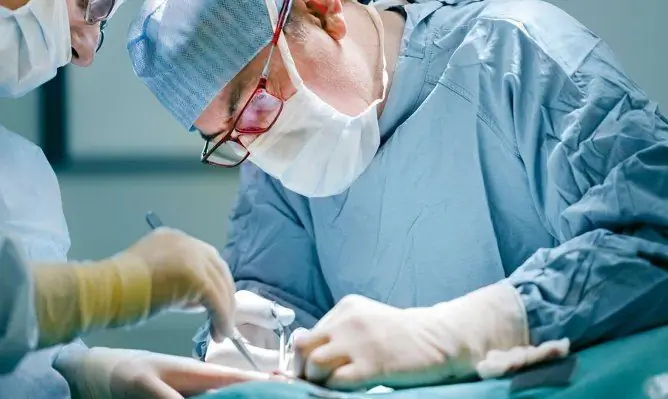- Author Rachel Wainwright [email protected].
- Public 2023-12-15 07:39.
- Last modified 2025-11-02 20:14.
Hemorrhoids after surgery: rehabilitation and possible complications
The content of the article:
- Physical activity
- Proper nutrition
- Eliminate pain
- Healing of the wound surface
-
Possible complications
- Bleeding
- Infectious inflammation
- Difficulty defecating
- Postoperative perianal edema
- Retention of urine
- Prolapse of the rectal mucosa
- Incontinence
- Anal stenosis
- Rectovaginal fistula
Hemorrhoids after surgery are extremely rare, subject to medical recommendations, relapse is excluded, which is one of the main advantages of surgical treatment.
Indications for surgical removal of hemorrhoids can be prolapsed hemorrhoids and frequent exacerbations of the disease, involvement of the surrounding fatty tissue in the inflammatory process, the development of anemia due to frequent heavy bleeding, pinching and ischemia of the nodes. Hemorrhoidectomy is also prescribed in cases where the internal nodes are strongly expressed and they cannot be removed with minimally invasive methods.

Correct rehabilitation after hemorrhoidectomy promotes rapid recovery and prevents relapse Correct rehabilitation after hemorrhoidectomy promotes rapid recovery and prevents relapse
How long is the rehabilitation period? Recovery from open hemorrhoidectomy usually takes 4-6 weeks, with closed hemorrhoidectomy it is reduced to three weeks. What is the right approach to rehabilitation, how to behave after hemorrhoid surgery and what to do to make the recovery go smoothly?
Physical activity
On the first day after the operation, bed rest is prescribed, and the next day, if the patient's well-being allows, he is allowed to get up and move around the room. If the patient does not feel well, the doctor may allow him to rise on the third or fourth day or later.
As the wound heals, it is recommended to do light exercises lying or standing, such as Kegel exercises. The first time the exercises are performed for five minutes a day, gradually increasing their duration and intensity. On the fifth day, short walks are allowed. Loads should be gentle, not causing overvoltage. Physical activity will prevent the development of blood stagnation, prevent thromboembolism, protect against varicose veins of the lower extremities, help heal tissues by activating blood flow, and restore the tone of the muscles of the pelvis and perineum.
Patients are allowed to walk before sitting down. The first attempts to sit down can be made only after the disappearance of pain in the anus.
For sitting, it is better to purchase an orthopedic pillow with a notch in the middle. The use of a cushion in the form of a circle allows you to evenly distribute the weight on the pelvic bones while sitting, reduce the load on the veins of the pelvic floor and anus. It is recommended to use the healing pillow during the first months after surgery.

Dosed exercise plays an important role in the recovery process Dosed exercise plays an important role in the recovery process
In the first few months after the operation to remove hemorrhoids, it is strictly forbidden to lift a load of more than two kilograms.
You can resume sports in about three months. To avoid relapse, you need to give up strength sports, exercise with a lot of weight, training on strength equipment. Prohibited physical activity also includes exercises with a heavy load on the press.
But swimming improves microcirculation, eliminates venous congestion in the pelvic region, and reduces pressure on the abdominal cavity. Jogging and walking can also help strengthen your abdominal muscles and speed up blood flow to your pelvic veins. Gymnastic exercises and yoga have an effective effect on blood circulation in the deep muscles of the small pelvis.
Proper nutrition
The main condition for a successful recovery after hemorrhoid surgery is the establishment of proper nutrition.
On the first day of the postoperative period after removal of hemorrhoids, a hunger pause is shown - a complete refusal to eat. Food is gradually introduced from the second day. To reduce the load on the digestive tract and to avoid injury to the wound with solid feces, the products are crushed. What can you eat in the postoperative period? The basis of the diet should be gentle, soft foods rich in fiber and dietary fiber. The daily diet is divided into 6-7 small portions.
We recommend porridge in water, light soups with vegetable broth, pureed soups, stewed vegetables and fruits, vegetable casseroles, low-fat dairy products, hard-boiled chicken and quail eggs, lean meat and fish, whole grain bread.
Meat and fish are boiled, baked or steamed. Low-fat veal, chicken or turkey fillets, boneless sea fish are suitable. It is useful to season dishes with olive or linseed oil. Water should be drunk in sufficient quantities, at least four glasses a day, in the morning on an empty stomach it is recommended to drink a glass of water. Fruit drinks, unsweetened dried fruit compotes, herbal teas are useful.
Fatty meats, legumes, mushrooms, sorrel, cabbage are excluded from the diet. Spicy, fried, smoked and pickled dishes, baked goods, sweets, rye bread, strong black tea and coffee, carbonated water, whole milk, and alcoholic beverages are prohibited.
Eliminate pain
After hemorrhoidectomy, patients experience pain for some time. In the first days after surgery to remove hemorrhoids, patients can also be seriously worried about tampons and drains inserted after surgery. The severity of pain usually decreases after 3-4 days.
The pain syndrome in the first days is stopped by intramuscular administration of analgesics, then gradually they switch to local agents (Relief, Proctosan, etc.), which have anesthetic, anti-inflammatory and antimicrobial effects. The use of rectal analgesic suppositories (Anestezol, Procto-Glivenol, Ultaprokt, Relief suppositories) also helps prevent constipation and helps to heal anal fissures.
The doctor may also prescribe non-steroidal anti-inflammatory drugs, non-narcotic analgesics. With severe pain syndrome caused by damage to nerve endings, injections into the rectal area are prescribed. On the fifth day after surgery, they switch to tablet forms of drugs.

To relieve pain in the postoperative period, local anesthetics are prescribed To relieve pain in the postoperative period, local anesthetics are prescribed
In addition to analgesics, drugs are used to improve the tone of the walls of veins and blood vessels, to prevent congestion (Phlebodia, Detralex, Venarus), which also eases the condition.
Medicines and their dosage are selected by the attending physician.
Healing of the wound surface
The first dressing is usually performed on the fourth day after the operation. The wound surface is treated with hydrogen peroxide, a tampon with a syntomycin emulsion is introduced into the intestinal lumen. Then a perineal bandage is applied to protect against infection.
Further dressings are made every other day. The procedures consist of cleaning the wound and treating it with drugs. For the treatment of hemorrhoids after surgery, local drugs are used that promote the regeneration of damaged areas of the mucous membrane (Solcoseryl, Levomekol, ointments and suppositories with methyluracil or extract from sea buckthorn berries, Natalsid suppositories). They also accelerate the healing processes of a bath with a weak solution of potassium permanganate, a decoction of chamomile flowers, sage, etc.
In order to prevent infection in the postoperative period, antibiotics are prescribed.
The patient should toilet the anus after each bowel movement; instead of toilet paper, it is better to use wet antiseptic wipes or a soft cloth.
Possible complications
The risk of complications when removing hemorrhoids using modern methods is minimized, however, it is impossible to completely exclude complications and unwanted reactions from the body.
Bleeding
The release of blood in the area of the sutures can begin due to trauma by hard feces, insufficient cauterization of the blood vessel during surgery, or if anal fissures are damaged. Topical hemostatics or re-flashing of the damaged area of the vessel help stop bleeding.
Infectious inflammation
It develops when the rules of asepsis are violated. It is eliminated by taking antibacterial drugs.
Difficulty defecating
During the healing process, an accumulation of feces in the large intestine is often observed. During the entire period of rehabilitation after surgery for hemorrhoids, bowel movements can be painful. How to go to the toilet so that the rectal mucosa is not injured by hard feces? To facilitate the process, laxatives and anesthetic gels are used.
Sometimes, due to severe pain during bowel movement, the patient develops psychological constipation - a fear of defecation. To reduce pain in such cases, pain relievers and nitroglycerin ointment are prescribed, which relaxes the anal sphincter.
Postoperative perianal edema
Retention of fluid in the perianal tissues is caused by impaired permeability of the vascular wall, exposure to the vascular wall of bacterial toxins. To relieve edema, phlebotropic agents or glucocorticosteroids can be used.
Retention of urine
Dysuric disorders occur mainly in men in the first hours after surgery. In such cases, urine is diverted using a catheter.
Prolapse of the rectal mucosa
It is provoked by damage to the neuromuscular fibers of the walls of the rectum during surgery. This rare complication can be treated surgically or conservatively.
Incontinence
Fecal, gas, or urinary incontinence may result from defects in the sphincter rectum that develop after hemorrhoid surgery, usually due to trauma to the anal canal. For treatment, a set of measures is used, including drug therapy, a course of electrical stimulation of the anal ring muscles, and physiotherapy exercises. In severe cases, a second operation is performed.
Anal stenosis
Narrowing of the rectal lumen occurs in the late postoperative period due to the growth of scar tissue or, much less often, in the early, as a result of improper suturing of the surgical wound. Treatment consists in developing the anal canal using special dilators, in severe cases, plastic surgery is performed.
Rectovaginal fistula
The formation of fistulas between the vagina and the rectum can be caused by the penetration of pathogenic bacteria into the hemorrhoid. Extensive internal foci of suppuration are treated surgically.
YouTube video related to the article:

Anna Kozlova Anna Kozlova Medical journalist About the author
Education: Rostov State Medical University, specialty "General Medicine".
Found a mistake in the text? Select it and press Ctrl + Enter.






